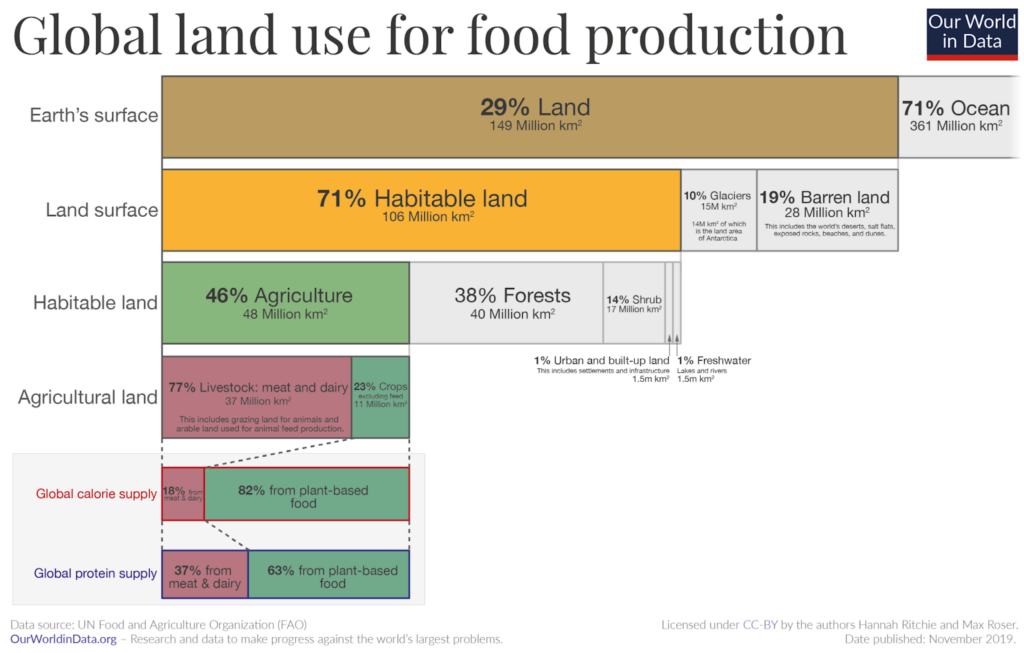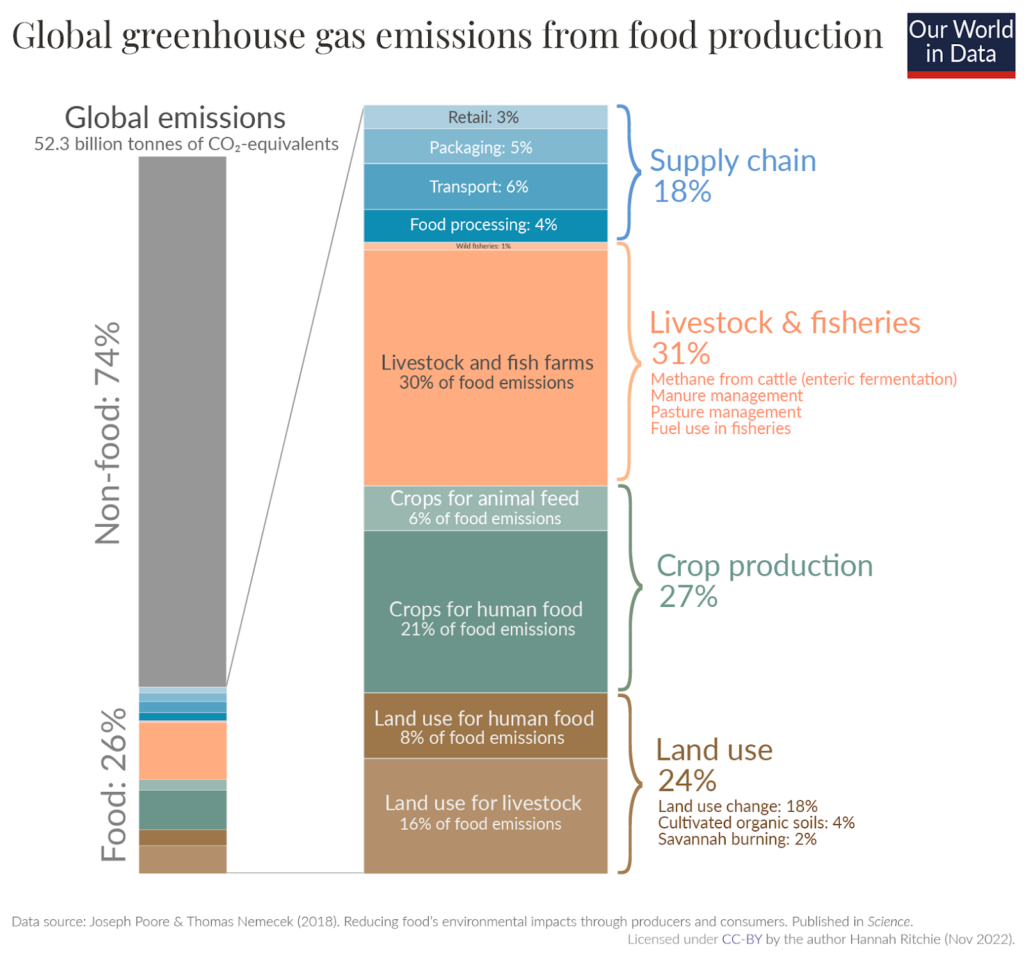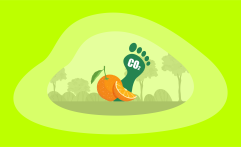Is Eating Grapes Ethical & Sustainable? Here Are the Facts
Affiliate Disclosure
Hey fellow impactful ninja ?
You may have noticed that Impactful Ninja is all about providing helpful information to make a positive impact on the world and society. And that we love to link back to where we found all the information for each of our posts.
Most of these links are informational-based for you to check out their primary sources with one click.
But some of these links are so-called "affiliate links" to products that we recommend.
Why do we add these product links?
First and foremost, because we believe that they add value to you. For example, when we wrote a post about the environmental impact of long showers, we came across an EPA recommendation to use WaterSense showerheads. So we linked to where you can find them. Or, for many of our posts, we also link to our favorite books on that topic so that you can get a much more holistic overview than one single blog post could provide.
And when there is an affiliate program for these products, we sign up for it. For example, as Amazon Associates, we earn from qualifying purchases.
What do these affiliate links mean for you?
First, and most importantly, we still only recommend products that we believe add value for you.
When you buy something through one of our affiliate links, we may earn a small commission - but at no additional costs to you.
And when you buy something through a link that is not an affiliate link, we won’t receive any commission but we’ll still be happy to have helped you.
What do these affiliate links mean for us?
When we find products that we believe add value to you and the seller has an affiliate program, we sign up for it.
When you buy something through one of our affiliate links, we may earn a small commission (at no extra costs to you).
And at this point in time, all money is reinvested in sharing the most helpful content with you. This includes all operating costs for running this site and the content creation itself.
What does this mean for me personally?
You may have noticed by the way Impactful Ninja is operated that money is not the driving factor behind it. It is a passion project of mine and I love to share helpful information with you to make a positive impact on the world and society. However, it's a project in that I invest a lot of time and also quite some money.
Eventually, my dream is to one day turn this passion project into my full-time job and provide even more helpful information. But that's still a long time to go.
Stay impactful,
Grapes are a delicious and versatile fruit, with 30% being consumed directly, and the other 70% used to make wine. Originating as a crop around 8,000 years ago, grapes have a long agricultural history. However, there can also be some very unethical and unsustainable components to the grape industry. So we had to ask: Is eating grapes ethical and sustainable?
Eating grapes is very unethical. This is mainly because of reports of child labor and wage theft on US farms. However, grape farms have also been reported to pay higher wages than many other fruit farms.
Eating grapes is very unsustainable. The main contributing factors to this are their use of styrofoam and plastic packaging, high pesticide usage, and high carbon footprint. However, they use less harmful fertilizers than many other fruits and use land very economically.
In this article, we will assess both the ethical and sustainability practices of the grape industry. Through these two lenses, you will be able to gain in-depth knowledge of the overall impacts of the grapes that you eat!
Here’s How We Assessed the Ethics & Sustainability of Grapes
The Sustainability Assessment of Food and Agriculture Systems (SAFA) is one of the ways we measure the externalities of our actions, like the consumption of grapes. It is a holistic assessment based on the potential impact of food and agriculture operations on the environment and people. Those impacts are changes in our environment that can have adverse effects on the air, land, water, fish, and wildlife or the inhabitants of the ecosystem.
“Ethical: The discipline concerned with what is morally good and bad and morally right and wrong”
Encyclopedia Britannica
Ethics and sustainability are closely interconnected concepts that share a common objective: the well-being and preservation of our planet, including all its life and future generations.
“Sustainable: The ability to be maintained at a certain rate or level | Avoidance of the depletion of natural resources in order to maintain an ecological balance”
Oxford Dictionary
Basically, all goods and services you buy—including grapes—leave an impact on people, animals, and our environment. And when it comes to food in general—and grapes in specific—the following are key factors for their ethics and sustainability:
- Social and economic conditions: The ethics of food crucially depends on the social and economic conditions of the farmers who grow them. Especially on fair labor practices, including fair wages and safe working conditions.
- Seasonality: Eating seasonally is a lever of sustainability. The two key reasons are that seasonal food is more likely grown in their “natural growing season” without using greenhouses, and also more likely to be grown locally.
- Land requirements: Large parts of the world that were once covered by forests and wildlands are now used for agriculture. 10 million hectares of forest are destroyed annually and 50% of the world’s habitable land is now used for agriculture. This loss of natural habitat has been the main driver for reducing the world’s biodiversity.
- Water footprint: 70% of global freshwater is now used for agricultural purposes. By assessing the water footprint of a particular food, we can determine how our limited freshwater resources are being consumed and polluted.
- Pesticide and fertilizer usage: Pesticides and fertilizers provide a range of agricultural benefits. However, numerous studies link pesticides and fertilizers to serious effects on human health, along with disruptions to vital ecosystems and the spread of aquatic dead zones.
- Carbon footprint: The carbon footprint is one of the ways we measure the effects of our human-induced global climate change. Today, food production accounts for over a quarter (26%) of global greenhouse gas emissions.
- Waste generation: Food and its packaging account for almost 45% of the materials landfilled in the US alone. And packaging sent to landfills, especially when made from plastics, does not degrade quickly or, in some cases, at all.
To understand the overall ethics and sustainability of grapes, we must assess each of their key factors. This Sustainability Assessment of Food and Agriculture Systems (SAFA) is a tool developed for assessing the impact of food and agriculture operations on the environment and people. And this tool helps us to evaluate whether eating grapes is ethical & sustainable.
Here’s How Ethical & Sustainable Eating Grapes Is
The overall ethics & sustainability of grapes is fairly low. This is mainly caused by land encroachment, irrigation requirements, reports of child labor in the US, plastic and styrofoam packaging, and a high carbon footprint.
There are some positive qualities grapes have in terms of their ethics and sustainability. For example, they have very economical land usage, and they don’t use fertilizers that are known to be very unsustainable, such as nitrogen fertilizer. However, other aspects of their processes engage in very unsustainable practices.
So, let’s have a look at the ethics & sustainability impact of each key factor of grapes!
| Key Assessment Factors | Ethics & Sustainability |
| Social and economic conditions of grapes | Grapes’ social and economic conditions are very bad. There have been reports of child labor within the US grape industry, though there are also reports of high wages for workers. |
| Seasonality of grapes | Grapes’ seasonality is between May and January, meaning that they are only imported from Peru in the springtime. |
| Land requirements for grapes | Grapes’ land requirements are fairly low. However, grape vineyards are vulnerable to soil erosion and have impacted California’s wildlife significantly, meaning they are very unsustainable at this stage. |
| Water footprint of grapes | Grapes have a very low water requirement of 25–30 inches of water per year. However, because of where they grow, they still need some irrigation. As a result, their water footprint is moderately high. |
| Agrochemical usage for grapes | Grapes’ agrochemical usage is moderate. The pesticides they use can be very unsustainable. However, their fertilizers are more benign. |
| Carbon footprint of grapes | Grapes have a very high carbon footprint of 0.64 kg (1.42 lbs) of CO2e per pound of grapes. This is mainly because of their irrigation needs, high pesticide use, refrigeration requirements during transportation, and high levels of packaging. |
| Waste generation of grapes | Grapes’ waste generation is very high. This is because they use harmful packaging materials like styrofoam and plastic, which are very hard to recycle. |
These are the overall summaries, but there is a lot more to the story. In the next few sections, we will dive deeper into each stage to illustrate to you all the important aspects of grapes’ ethics & sustainability.
How Ethical & Sustainable Are the Social and Economic Conditions for Grapes
Grapes’ social and economic conditions are very bad. There have been reports of child labor within the US grape industry, though there are also reports of high wages for workers.
Everything we consume was made or harvested by somebody. In past centuries, this was often someone who lived in your community and who you might have even known personally. But through the rise of globalized distribution systems, we have become increasingly alienated from the people who make our food. This leaves a lot of room for exploitation and abuse, both of which are rampant in the food industry. Here, we will look at how the grape industry fares in relation to these ethical questions.
How ethical & sustainable are the social and economic conditions of growing grapes?
- Are farmers paid fair wages to grow grapes: Californian grape workers are paid very good wages by American standards, one report indicating they could make as much as $20 an hour. This means that grape workers, at least in the US, ostensibly make a decent wage.
- How safe are the working conditions to grow grapes: There are several types of dangers that grape farmers typically experience, mainly musculoskeletal disorders and tractor-related injuries. However, these are fairly typical amongst agricultural workers. Grapes also have very high rates of pesticide usage, which can be a hazard to the health of farm workers.
- Are there reports of child or forced labor to grow grapes: There have been reports of child labor within the US grape industry. There have also been some reports of forced labor within the grape industry, mainly in Brazil. However, these are mainly in wineries.
- What is the wider economic impact on the communities that grow grapes: Many grape workers in California are employed under the migrant worker program. Although they do make decent wages, they are also open to unique vulnerabilities and exploitation.
In short, despite their high wages, the grape industry has engaged in some seriously unethical practices, mainly due to reports of child labor in the US.
How Ethical & Sustainable Are the Seasonality for Grapes
Grapes’ seasonality is between May and January, meaning that they are only imported from Peru in the springtime.
Every fruit has a natural season in which they grow, usually lasting a couple of months, which can range depending on the region. However, international demand for every kind of fruit is year-round. This demand is often met by importing fruits from tropical places which can grow year-round, or by growing them in greenhouses. Both of these methods use more resources and are thus less sustainable than conventional farming. Here, we will look at how the grape industry accommodates year-round demand.
How ethical & sustainable is it to grow grapes in-season vs out-of-season?
- When is the natural season for growing and harvesting grapes: Grapes are in season for most of the year, between May and January. They are only out of season in the early spring. This means that most of the year, you can find domestically-grown table grapes.
- How are grapes naturally grown in-season: In-season, most grapes in the US are grown in California. This means that they need to be transported shorter distances and are thus more sustainable.
- How are grapes grown out-of-season: When the US does import grapes, they mainly come from Peru, as well as Chile and Mexico. Grapes imported from these countries take more energy to get to your supermarket and are thus less sustainable.
In short, grapes’ long seasonality means that there is only a small portion of the year when they need to be imported. However, during this time, they are less sustainable.
How Ethical & Sustainable Are the Land Requirements for Grapes
Grapes’ land requirements are fairly low. However, grape vineyards are vulnerable to soil erosion and have impacted California’s wildlife significantly, meaning they are very unsustainable at this stage.

The growth stage has a major impact on fruits’ sustainability. The amount of land used, especially in relation to its expansion, the method with which they are grown, and their effect on surrounding land and wildlife are all important factors. In this section, we will look at the ways in which grapes’ land usage affects their sustainability.
How ethical & sustainable are the land requirements for growing grapes?
- What is the land usage of grapes: Grapes can yield between 20 and 50 tons per hectare. This is an above-average yield among fruits and so their land yield is fairly sustainable.
- Where and how are grapes grown: Most grapes are grown in California. Grapes are grown on vines in farms known as vineyards. Remarkably, grape vines can actually sequester carbon through photosynthesis. Carbon sequestration is the process wherein certain plants capture carbon from the atmosphere and store it in the ground. This helps to offset part of grapes’ carbon footprint and thus makes them more sustainable.
- How does the growing of grapes affect soil fertility and erosion: Unfortunately, grape vineyards have some of the highest rates of soil erosion among fruits. Soil erosion is very unsustainable, mainly because of water pollution and wildlife loss. Therefore, the fact that vineyards cause a serious amount of soil erosion means they are very unsustainable at this stage.
- How does the grapes industry affect the loss of habitable land: Grapes, especially wine grapes, use a significant amount of land in California. Their land use has been growing over the years and as a result, has been encroaching significantly on California’s natural landscape.
- How does the grapes industry affect wildlife and biodiversity: The conversion of California’s natural spaces due to agriculture has led to a significant uptick in habitat loss. Habitat loss is the main cause of endangered species around the world.
In short, the grape industry contributes significantly to soil erosion and habitat loss in California. So, they are very unsustainable, despite their economic land yield and carbon sequestering properties.
How Ethical & Sustainable Is the Water Footprint of Grapes
Grapes have a very low water requirement of 25–30 inches of water per year. However, because of where they grow, they still need some irrigation. As a result, their water footprint is moderately high.
Water usage is one of the most important factors in a fruit’s sustainability. Practices like irrigation use significant resources and can cause pollution, and as such, factors like the amount of water used, where it is sourced, as well as the way they affect the water sources around them, are all important. Here, we will look at these different angles of grapes’ water footprint.
How ethical & sustainable is the water footprint of growing grapes?
- What is the overall water usage of grapes: Grapes need around 25–30 inches of water per year. This is a very low water requirement compared to other fruits. For example, pears need around 50 inches per year, and watermelons require up to 100 inches. Therefore, grapes’ water usage is fairly low.
- What is the green water footprint of grapes: The green water footprint is the amount of water from precipitation stored in the soil and used by plants for growth. Most American-consumed grapes grow in California, which only gets around 22 inches of rain per year. This is not quite enough rainfall to cover grapes’ water requirement, and so most of the rainfall in the area will be directed towards grape production. This means that their green water footprint is high.
- What is the blue water footprint of grapes: The blue water footprint is the amount of water sourced from surface (such as rivers or lakes) or groundwater resources. Because California’s annual rainfall is not quite high enough to cover grapes’ water requirements, they will need a small amount of irrigation. This means that their blue water footprint is moderate.
- What is the gray water footprint of grapes: The gray water footprint is the amount of freshwater required to clean up water pollution to meet certain quality standards. Essentially, it’s the amount of water needed to make polluted water clean enough to be safe and healthy for humans and the environment. Grapes have exceptionally high pesticide rates. This means that they need a lot of water to clean up their pesticide residue and so their gray water footprint is high.
- How does the grape industry affect freshwater and ocean pollution: Pesticides have been identified as a major polluter of oceans and other water sources. Therefore, the fact that grapes use a significant amount of pesticides heightens their water pollution. Irrigation is also very unsustainable, but because grapes only use a small amount of irrigation, this is not as severe an impact.
In short, grapes’ high use of pesticides, but low use of irrigation means that they are somewhat unsustainable at this stage.
How Ethical & Sustainable Is the Agrochemical Usage for Grapes
Grapes’ agrochemical usage is moderate. The pesticides they use can be very unsustainable. However, their fertilizers are more benign.
Pesticides and fertilizers are agrochemicals that are very unsustainable and damaging to ecosystems. This is because they require resources to create and can easily run off into groundwater and soil systems. Here, we will look at how sustainable grapes’ pesticide and fertilizer rates really are.
How ethical & sustainable is the agrochemical usage of growing grapes?
- What is the pesticide usage of grapes: Grapes have very high pesticide usage, with around 87% of sampled fruit containing pesticides. Pesticides can cause many kinds of environmental damage, including poisoning surrounding wildlife. Leakages can also get into soil and groundwater. As a result, grapes are very unsustainable at this stage.
- What is the fertilizer usage of grapes: Grapes use primarily potassium fertilizer. The good news is that potassium fertilizers have been found to be somewhat sustainable. Therefore, grapes are fairly sustainable at this stage.
- Are there any known issues connected to the agrichemical usage for grapes: In a 2021 study, 61% of the 122 pesticides that grapes were tested for were considered “highly hazardous.” Many are linked with various cancers, endocrine disruption, and even birth defects. These issues show that the pesticides found on grapes can be harmful to humans as well as the environment.
In short, the amount and types of pesticides that grapes use are highly damaging to the environment, though their fertilizer usage is less harmful.
How Ethical & Sustainable Is the Carbon Footprint of Grapes
Grapes have a very high carbon footprint of 0.64 kg (1.42 lbs) of CO2e per pound of grapes. This is mainly because of their irrigation needs, high pesticide use, refrigeration requirements during transportation, and high levels of packaging.

Carbon footprint is one aspect of the overall sustainability of a fruit. It essentially measures how much carbon or other greenhouse gasses the production of fruits emits into the atmosphere. Emissions from product manufacturing, irrigation, transportation fuel, and landfills all add up to create the overall carbon footprint of a fruit. Let’s see how the carbon footprint of grapes contributes to their overall sustainability.
How ethical & sustainable is the carbon footprint of grapes?
- What is the overall carbon footprint of grapes: The overall carbon footprint of grapes is 0.64 kg (1.42 lbs) of CO2e per pound of grapes. This means that for every pound of grapes produced, 0.64kg of carbon is released into the atmosphere. That’s the equivalent of driving a car over a mile and a half! Grapes’ carbon footprint is significantly higher than most fruits.
- What are the main contributors to the carbon footprint of grapes: The main contributing factors to grapes’ carbon footprint are their irrigation requirements, pesticide use, and plastic packaging.
- Which life-cycle stage of grapes has the highest carbon footprint: The life cycle stage of grapes that has the highest carbon footprint is waste. This is because grapes use plastic and styrofoam packaging which have very high emissions when created and disposed of.
In short, though grapes have some positive qualities, they create a very high amount of carbon emissions, much higher than the average fruit.
How Ethical & Sustainable Is the Waste Generation of Grapes
Grapes’ waste generation is very high. This is because they use harmful packaging materials like styrofoam and plastic, which are very hard to recycle.
When fruit waste, either in the form of packaging or organic materials, is disposed of, it can cause a lot of problems. Whether it’s damaging wildlife, getting into oceans, emitting methane, or dissolving into microplastics that contaminate groundwater, all these materials have their part to play. The sheer amount of waste we produce is reaching a crisis point and won’t be able to continue much longer. In this section, we will look at how sustainable grapes’ waste generation is.
How ethical & sustainable is the waste generation of grapes?
- What is the packaging of grapes: Grapes are packaged in either cardboard boxes, styrofoam boxes, or plastic bags and containers. Though cardboard is one of the more sustainable types of packaging, it still contributes to deforestation. Styrofoam, on the other hand, is very unsustainable during its production stage. Plastic is also very unsustainable during its production stage. As a result, it is very unsustainable to produce all the different kinds of grape packaging.
- How is the packaging of grapes disposed of: Cardboard has a very high recycling rate at 89%. Plastic, however, has a very low recycling rate of 9% and styrofoam has an even lower recycling rate at less than 1%. This means that most plastic and styrofoam grape packaging is ending up in landfills. Landfills have many unsustainable qualities, including land clearance and chemical pollution. Furthermore, styrofoam and plastic can both take up to 500 years to decompose. As a result, disposing of grape packaging is very unsustainable.
- How are grapes disposed of: Grapes typically come on vines that aren’t eaten. However, some grapes are sold loose. For those that come on vines, they can technically be composted. However, only 4% of food waste is actually composted. This means that for grapes sold with vines, a significant amount will end up in landfills. What’s worse is that food waste is particularly unsustainable as it releases a greenhouse gas called methane when it is put in landfills.
In short, the fact that grapes use both plastic and styrofoam packaging, some of the most environmentally-damaging packaging materials out there, means that they are very unsustainable at this stage.
What Have Been Historical Ethics & Sustainability Issues Connected to the Grape Industry
The grapes industry has been very unethical and unsustainable over the years, mainly due to reports of wage theft and the impact on California’s land loss and water pollution.
All fruits have had a complex road toward global distribution. They originate in one part of the world and often travel far to end up in your local supermarket. From farm to table, some of our favorite fruits have racked up some serious damage along the way. Whether it’s exploiting labor, deforestation to meet demand, water pollution, or disruption of wildlife, most fruits have left a path of destruction. Let’s see how grapes have fared throughout history.
What have been the key ethical & sustainable issues of the grape industry?
- Has labor been exploited because of grape production: There have been some instances of unfair wages and wage theft in the US grape industry. One instance was in 2022, when a California grape grower was forced to return over $50,000 in unpaid wages. This kind of case shows that workers have dealt with wage theft over the years.
- How much land has been lost because of grape production: There have been several booms in California’s grape market that have affected their land usage. One particularly large boom happened between 1990 and 1997 when California lost around 4,500 hectares of land to grape farming, which is around the size of San Clemente. That number has since ballooned to around 120,000 hectares by 2021, which is four times the size of San Francisco. This huge amount of land has caused significant loss for the natural landscape of California.
- Which wildlife species have been negatively impacted or displaced because of grape production: California’s wildlife has seen significant encroachment in the past decades due to agricultural expansion. This has led to some of California’s species becoming endangered. Some of the most endangered species in the state are the gray wolf, the giant kangaroo rat, and the California condor. Excessive vineyard production has greatly impacted their living situations.
- Have water sources and soil been contaminated because of grape production: Grapes’ use of excessive pesticides has had a major impact on water sources. As of 2021, around 10% of surface water and 2% of groundwater contained a significant amount of pesticides. From this perspective, grapes’ high pesticide usage has had a very damaging impact on water sources.
In short, grape agriculture’s infringement on California wildlife, as well as their reports of wage theft and high pesticide usage means that they have been considerably unethical and unsustainable over the years.
How Can You Reduce Your Environmental Impact and Offset Your Personal Carbon Footprint
There are a few things you can do to make your grape consumption more ethical and sustainable, while still enjoying them. You can also consider offsetting your personal and grape-related carbon emissions, which work to remove carbon emissions elsewhere that are then attributed to you. Here, we will walk you through how to accomplish both of these things.
How Can You Shop for Grapes More Ethically & Sustainably
In this section, we give you a short list of ways you can consume grapes in a more sustainable way. This list is designed to target the most unsustainable parts of grapes’ life-cycle:
- Buy in-season grapes: When grapes are out of season, they are typically imported, rather than grown in California. If you limit your grape consumption to between May and January, then you will be eating more sustainable grapes.
- Buy grapes without packaging: Grapes’ use of styrofoam and plastic packaging is one of their most unsustainable aspects. If you buy grapes with less packaging, paper packaging, or no packaging at all, you will be helping to mitigate a significant amount of grapes’ unsustainability.
- Buy organic grapes: Grapes have very high pesticide usage compared to other fruits. Organic farms, however, generally avoid high amounts of chemical pesticides and nitrogen fertilizers and so they are good to support if you want to reduce your pesticide and fertilizer impact. Plus, fewer chemicals means that the conditions on farms are somewhat safer for workers, making organic grapes both more ethical and more sustainable.
Following some of these methods can really help you to make your grape-eating more sustainable. None of these will completely eradicate the negative impacts, since there are always effects that may be outside of your control. But some reduction is always better than nothing!
Which Organizations Can You Support to Help Promote Ethics & Sustainability
While grape production engages in some very unsustainable practices, there are also some organizations that help you change the parts of these processes that would otherwise be outside of your control. These organizations are working hard to prevent and reverse damage to the environment caused by industries like grape agriculture, towards a more sustainable future.
In the table below are some of the best charities that work in the areas where grape production are very unsustainable—and beyond:
Though it is helpful to boost the sustainability of your personal grape consumption, supporting these organizations takes your positive impact a step further. You will be reaching far beyond your own consumption impacts and helping to build a better world for everyone!
How Can You Offset Your Personal Carbon Footprint
The carbon footprint is a key part of how sustainable we live. And it is one of the ways we measure the effects of our human-induced global climate change. Yes, even from eating grapes!
“Carbon footprint: the amount of greenhouse gasses and specifically carbon dioxide emitted by something (such as a person’s activities or a product’s manufacture and transport) during a given period”
Merriam Webster
Basically, it is the amount of carbon emitted by you as an individual or an organization providing you with goods and services – including grapes:
- This includes GHG emissions from producing the products that we use and foods that we eat (e.g., power plants, factories or farms, and landfills)
- GHG emissions from fuel that we burn directly or indirectly (e.g., logistics and transportation, cooling or heating facilities),
- as well as the GHG emissions attributed to how we consume these products and foods.

Carbon offsets are reductions in carbon emissions that are used to compensate for carbon emissions occurring elsewhere – for example for the carbon emissions that are associated with grapes. They are measured in tons of CO2 equivalents and are bought and sold through international brokers, online retailers, and trading platforms on what is known as the global carbon offset market.
“Carbon Offset: a way for a company or person to reduce the level of carbon dioxide for which they are responsible by paying money to a company that works to reduce the total amount produced in the world, for example by planting trees”
Oxford Dictionary
In terms of grapes – and indeed all food types – there will always be a carbon footprint, because of the resources it takes to get your food from farms to the place where you’ll eventually eat them. And while there are ways to reduce your carbon footprint when shopping for grapes, carbon offsets would be a way to reduce your CO2e emissions all the way down to net zero (or even to become climate positive).
However, when you purchase carbon offsets, it’s important that they actually make a difference in offsetting (aka reducing) total carbon emissions. To achieve that, the following are key criteria:
- Carbon offset projects have to be effective (different projects have different effectiveness rates)
- Carbon offset projects have to be additional
- Carbon offset projects have to be permanent
- The claims from carbon offset projects have to be verifiable
To find the best carbon offsets for you personally, check out our full guide on the best carbon offsets for individuals, where you’ll also learn more about how these carbon offset projects work, what their respective offsetting costs are, and what your best way would be to offset your own carbon emissions.
Final Thoughts
Grapes are certainly not the most sustainable or ethical fruit. They have very high carbon footprints, use a significant amount of pesticides, and use some of the most harmful types of packaging. They also have reports of major violations like child labor and wage theft. However, there are still plenty of things that you can do to mitigate the damage that comes from consuming grapes. Recycling and reducing your grape packaging, supporting organic grape farms, and supporting organizations that help tackle the bigger issues of the agricultural sector can all help you to reduce your harm and be a more ethical and sustainable grape consumer!
Stay impactful,

Sources
- NIFA: National Wine Day: Growing Great Grapes
- IPM Missouri: Grapes: A Brief History
- Food and Agriculture Organization of the United Nations: SAFA (Sustainability Assessment of Food and Agriculture systems) Guidelines
- Food Ethics Council: What is food ethics?
- The Fair Labor Association: Agriculture Standards
- MDPI Sustainability: Eating in Season—A Lever of Sustainability? An Interview Study on the Social Perception of Seasonal Consumption
- MDPI Foods: The Role of Local Seasonal Foods in Enhancing Sustainable Food Consumption: A Systematic Literature Review
- UN Environment Programme: Environmental Impact Assessment and Strategic Environmental Assessment: Towards an Integrated Approach
- Our World in Data: The environmental impacts of food and agriculture
- Our World in Data: Global land use for food production
- World Health Organization: Preventing disease through healthy environments: a global assessment of the burden of disease from environmental risks
- ScienceDirect (Biological Conservation): Worldwide decline of the entomofauna: A review of its drivers
- EPA: The Sources and Solutions: Agriculture
- EPA: Reducing Food Waste and Packaging
- FoodPrint: The Environmental Impact of Food Packaging
- Wine Grape Growing: Water Requirements and Quality
- Impactful Ninja: What is the Carbon Footprint of Grapes
- WGA: New Higher H2A Wage Rate
- PUBS: Grape Production
- CNBC: Child Field Workers
- Fair Planet: Brazil Forced Labor
- Food Manufacturing: California Grape Growers Violated Pay
- ILO: Labor Migration
- California Grown: How Are Grapes Grown
- Statista: Top 10 Grape Producing US States
- OEC: Grapes in the United States
- Wikifarmer: Grape Yield Per Hectare and Acre
- Extension: Table Grape Production
- AGMRC: Fruit Production
- Lodi Growers: Vineyard Management
- National Grid: What is Carbon Sequestration
- Impactful Ninja: Why is a Carbon Footprint Bad for the Environment
- MDPI: Soil Erosion as an Environmental Concern in Vineyards
- WWF: Soil Erosion and Degradation
- UCANR: Mapping Vineyard Expansion
- National Geographic: Endangered Species
- Impactful Ninja: What is the Carbon Footprint of Pears
- Impactful Ninja: What is the Carbon Footprint of Watermelons
- Water Footprint: What is a Water Footprint
- OEHHA: Indicators of Climate Change in California
- Wine Grape Growing: Vineyard Site Selection
- The Guardian: Cocktail of Pesticides on Almost All Oranges and Grapes
- Permaculture News: Pesticides and Water Pollution
- World Atlas: What is the Environmental Impact of Irrigation
- Friends of the Earth: Effects of Pesticides on Our Wildlife
- USGS: Pesticides in Groundwater
- RHS: Grapes: Outdoor Cultivation
- Direct Farm: Potassium
- Our World in Data: Environmental Impacts of Food
- NEPIS: Greenhouse Gas Emissions From a Typical Passenger Vehicle
- The produce Nerd: Grape Harvest Packaging
- Sonoco: Grape Packaging Sales
- TRVST: Environmental Impact of Cardboard
- CEHN: Styrofoam FAQs
- Biological Diversity: The Plastic Production Problem
- Also Known As: 12 Interesting Facts About Packaging Waste
- Insider: Is Styrofoam Recyclable
- Colorado: Environmental Impact of Landfills
- Clearly Clean: The Health and Environmental Issues of Polystyrene
- Forge Recycling: How Long it Takes Everyday Items to Decompose
- EPA: Sustainable Management
- GOV.BC: Waste Management
- Food Manufacturing: California Grape Growers Violated Pay Employment Laws
- Calag: Mapping Vineyard Expansion
- World Atlas: San Clemente California
- World Wine Weather: Red Wine Variety Acres
- AZ Animals: How Big is San Francisco
- Calag: Displaced by Agriculture
- NCBI: Pesticides in Drinking Water
- UVM: Sources of Nitrogen for Organic Farms
- Our World in Data: Greenhouse Gas Emissions per 1,000 kilocalories
- United States Environmental Protection Agency (EPA): Climate Change Terms
- Impactful Ninja: Best Charities That Advance Ethics Worldwide
- Impactful Ninja: Best Charities That Promote Sustainability
- Impactful Ninja: Best Charities That Help Farmers
- Impactful Ninja: Best Charities That Fight to Protect our Environment
- Impactful Ninja: Best Charities for Reforestation
- Impactful Ninja: Best Wildlife Conservation Charities
- Impactful Ninja: Best Charities for Protecting the Amazon Rainforest
- Impactful Ninja: Best Charities That Fight for Clean Water
- Impactful Ninja: Best Charities That Help Conserve Our Rivers
- Impactful Ninja: Best Charities to Save Our Oceans
- Impactful Ninja: Best Charities for Helping Farm Animals
- Impactful Ninja: Best Charities for Climate Change
- Impactful Ninja: Best Carbon Offsets for Individuals
- Impactful Ninja: Best Charities That Fight to Reduce Food Waste
- Impactful Ninja: Best Charities That Fight to End Plastic Pollution
- Impactful Ninja: Best Charities That Promote Recycling
- Impactful Ninja: Why Is a Carbon Footprint Bad for the Environment?
- Impactful Ninja: Best Carbon Offsets for Individuals




